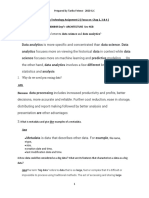0% found this document useful (0 votes)
17 views7 pagesGap
The document discusses the increasing prevalence and potential dangers of drones, particularly in crowded areas like airports and stadiums. It highlights the capabilities of the DroneWatcher app developed by Detect Global, which helps users detect unauthorized drones and track their movements through a network of users. Additionally, it explores the role of community-sector groups, particularly libraries, in providing valuable services and adapting to modern needs despite challenges and criticisms.
Uploaded by
2100011002Copyright
© © All Rights Reserved
We take content rights seriously. If you suspect this is your content, claim it here.
Available Formats
Download as DOCX, PDF, TXT or read online on Scribd
0% found this document useful (0 votes)
17 views7 pagesGap
The document discusses the increasing prevalence and potential dangers of drones, particularly in crowded areas like airports and stadiums. It highlights the capabilities of the DroneWatcher app developed by Detect Global, which helps users detect unauthorized drones and track their movements through a network of users. Additionally, it explores the role of community-sector groups, particularly libraries, in providing valuable services and adapting to modern needs despite challenges and criticisms.
Uploaded by
2100011002Copyright
© © All Rights Reserved
We take content rights seriously. If you suspect this is your content, claim it here.
Available Formats
Download as DOCX, PDF, TXT or read online on Scribd
/ 7























































































